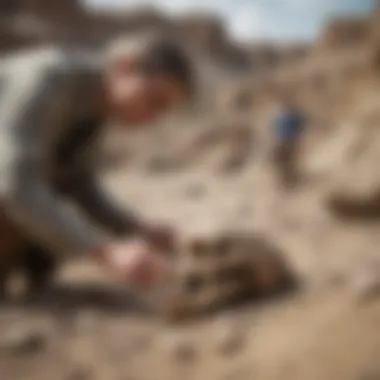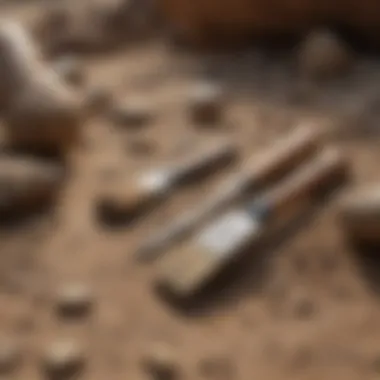Exploring Paleontology Dig Sites: Unveiling Earth's History


Intro
Paleontology dig sites are portals into Earth’s ancient past. They hold remnants of life forms that roamed our planet millions of years ago, offering valuable insight into ecosystems that no longer exist. These sites vary widely in type, age, and location. Understanding them is essential for anyone interested in the history of life on Earth.
Excavation techniques used at these sites have advanced over time, adapting to the unique challenges presented by different environments. Innovations in technology now allow paleontologists to extract and analyze delicate fossils with precision. As our tools improve, so does our understanding of how prehistoric organisms lived and interacted.
This article will explore important aspects of paleontological dig sites, from the types of sites found across the globe to the methodologies used in excavations. Both novice enthusiasts and seasoned collectors can benefit from this exploration, deepening their appreciation for natural history.
From significant locations like the Badlands of South Dakota to the world-renowned La Brea Tar Pits in California, every site unveils secrets of the past. By engaging with this content, readers can gain knowledge about the history encapsulated within these ancient remnants.
Let us start our journey into the fascinating world of paleontology.
Prelims to Paleontology Dig Sites
Paleontology dig sites are crucial in revealing the history of life on Earth. These locations serve as windows into the distant past, uncovering fossils that tell stories of ancient organisms. The information gathered from these sites enhances our understanding of evolutionary processes and ecological changes over millions of years. The study of these sites is not merely academic; it holds significance for advancing various scientific fields, and those passionate about fossils and natural history play an essential role.
Definition and Purpose
Paleontology dig sites refer to areas where systematic geological excavations take place to unearth fossils and other remnants of prehistoric life. The primary purpose of these dig sites is to collect data that contributes to the fossil record. Fossils can provide insights into species diversity, ecological dynamics, and how organisms adapted over time. For rock and fossil collectors, these sites offer the opportunity to participate in ongoing research while potentially finding valuable specimens. Engaging in this work often leads to a greater appreciation for the intricate history embedded in each fossil.
Historical Context
The field of paleontology has evolved significantly since its inception. Initially, fossil discovery was often accidental, with little understanding of their implications. Early paleontologists explored various regions but lacked methodological rigor. With time, practices in excavation and analysis improved. Significant discoveries in the 19th century, such as those in the Jurassic and Cretaceous periods, showcased the importance of fossils in understanding prehistoric life. Today's paleontological endeavors benefit from advancements in technology and interdisciplinary collaboration, resulting in more refined excavation techniques and heightened awareness of conservation. Conducting research at dig sites has now become a vital part of the global scientific community, with dedicated teams focusing on various aspects of paleontological study.
Types of Paleontology Dig Sites
Understanding the various types of paleontology dig sites is crucial for those interested in the field, especially for rock and fossil collectors. Each type offers unique opportunities and challenges, providing insights into prehistoric life that are invaluable for research and education. Knowledge of these sites allows enthusiasts to identify where to focus their efforts and how to engage authentically with the past.
Fossil Beds
Fossil beds play a significant role in paleontology. These are natural deposits where a high concentration of fossils can be found. They often represent environments that have undergone minimal disturbance over millions of years. This stability allows for the preservation of a diverse range of organisms, from plants to large dinosaurs.
Visiting fossil beds can be particularly rewarding. Collectors might discover rare specimens that contribute important information about biodiversity and ecological dynamics of past eras. Important fossil beds include the Hell Creek Formation, known for its rich dinosaur finds, and the Morrison Formation, which has yielded well-preserved dinosaurs.
Not only are fossil beds rich in historical information, but they also teach us about the geographical changes of Earth over time. By studying the layers of sediment where fossils are found, paleontologists can interpret past climates and environmental conditions.
Quarries
Quarries are another vital type of paleontology dig site. These locations are primarily mined for stones and minerals but can also yield significant paleontological finds. The process of extraction exposes rock layers that are otherwise hidden and holds immense potential for fossil discoveries.
Many significant fossil discoveries occur in quarries. For instance, the Dinosaur Quarry in Colorado provides a window into the life of dinosaurs that roamed the area millions of years ago. Such sites have both commercial and scientific value, balancing the need for natural resources with the desire to study and preserve historical finds.
Quarries often require careful planning and ethical considerations during excavation. Ensuring that fossils are collected without damage is crucial. Additionally, quarry operations should be mindful of the environmental impact.
Natural History Museums
Natural history museums represent a different aspect of paleontological engagement. They serve as repositories for fossils collected from various dig sites. Museums not only display these findings but also conduct research and educational outreach.
Visiting a natural history museum allows collectors and enthusiasts to admire fossils in context. Displays often include information about the fossils' origins, significance, and the conditions of their preservation. Noteworthy museums, such as the American Museum of Natural History, house extensive collections that can provide insights into the diversity of fossil life, and evolving theories in paleontology.
In addition, many museums offer workshops and lectures, providing a platform for interested individuals to learn more about paleontology. This educational dimension is essential for fostering a deeper interest in the field.
As palleontology continues to evolve, the significance of these types of dig sites remains clear. Each location contributes uniquely to the collective understanding of life on Earth in the past. The more individuals understand the role of these sites, the more they appreciate the importance of ongoing research and discovery in paleontology.
Notable Paleontology Dig Sites around the World
Paleontology dig sites across the globe serve as windows into the distant past. They are crucial for uncovering the history of life on Earth. These sites not only harbor fossils but also evidence of past climates and ecosystems. They attract both seasoned scientists and curious collectors. Here, we will explore several notable locations, each offering unique insights into prehistoric life.
The Hell Creek Formation
The Hell Creek Formation, located primarily in Montana, is renowned for its rich fossil deposits from the late Cretaceous period. This site is vital for those studying dinosaurs. Fossils recovered from this area include species like Tyrannosaurus rex and Triceratops. The sedimentary layers here are well-preserved, providing excellent records of prehistoric environments. For researchers, the Hell Creek Formation offers a unique opportunity to understand the transitions leading to the K-Pg extinction event, which dramatically reshaped life on Earth.


The La Brea Tar Pits
In Los Angeles, the La Brea Tar Pits present a different scenario. Here, natural asphalt seepages have trapped many prehistoric animals over thousands of years. The tar effectively preserved remains of mammoths, saber-toothed cats, and giant ground sloths. This site is instrumental in studying Pleistocene fauna. The ongoing excavation work continues to yield new discoveries, keeping the interest of both paleontologists and the public. Moreover, the surrounding museum provides an engaging context that connects visitors with ancient life.
The Gobi Desert
The Gobi Desert is not only known for its harsh conditions but also for its significant paleontological finds. With its vast expanse, this location has revealed important fossils, including those of Theropods and Protoceratops. The diverse geological formations here hint at a variety of life forms that once roamed this region. The discoveries from the Gobi have greatly enhanced our understanding of dinosaur evolution and migration patterns, making it a critical site for paleontological research.
The Burgundy Region of France
The Burgundy region offers rich marine fossils that date back to the Jurassic period. Notable finds include Ammonites and Belemnites, indicative of the ancient oceanic conditions that prevailed there. This area highlights the intricate relationship between geological processes and fossil formation. Researchers find this site particularly useful for understanding past marine ecosystems and the evolutionary transitions that marine life underwent. The regional charm also invites buffs to explore geological formations while learning about ancient seafloor environments.
"Paleontology digs hold the key to understanding not only the diversity of life but also the environmental history that shaped our planet."
These notable paleontology dig sites facilitate a deeper understanding of life's history on Earth. Each site includes unique features and discoveries that enrich the field of paleontology, drawing in a wide audience eager to learn more.
Methods Used in Excavation
The process of excavation in paleontology requires a carefully devised strategy. Methods used in excavation play a critical role in unearthing fossils that contribute to our understanding of ancient life. The techniques employed must prioritize not just the discovery of specimens but also the preservation of context where these fossils are found. This ensures that researchers can gather as much information as possible surrounding the findings. Through a keen attention to detail and robust methodologies, paleontologists are able to extract invaluable data that informs our knowledge of evolutionary biology, ecology, and climate history.
Site Preparation
Before actual digging begins, site preparation is key. This step includes multiple activities designed to prepare the site for exploration. First, a thorough assessment of the area is conducted, often including surveys and initial sampling. This can involve the use of tools like shovels and trowels for surface examination.
Environmental conditions are also taken into account. Factors like weather patterns, soil composition, and the potential for erosion need to be analyzed. Additionally, the layout of the dig site is planned meticulously, ensuring that essential markers indicate where excavations will occur. These preparations create a foundation for effective digging while reducing the risk of damaging potential finds.
Digging Techniques
Once site preparation is complete, various digging techniques come into play. Traditional methods involve hand tools such as pickaxes, shovels, and brushes, allowing for a careful approach to fossil recovery. In some cases, machinery like excavators may be employed to remove large amounts of sediment, but these must be used judiciously to avoid disturbing delicate structures.
Digging is conducted in layers, resembling a stratigraphic approach. Each layer is documented meticulously. Dates and descriptions are recorded to establish a timeline of findings. This technique reveals the changes in sediment and organisms over time, offering insight into past environments. Additionally, as fossils are uncovered, immediate photographs and notes are essential for preserving the conditions of their discovery.
Preservation of Finds
The preservation of finds is one of the most critical aspects following the excavation process. Once a fossil is carefully extracted, it must be treated with the utmost care to ensure its survival. Depending on the material of the fossil—such as bone or shell—different preservation techniques are applied.
Common methods include:
- Consolidation: Applying chemical agents to strengthen fragile specimens.
- Storage: Keeping fossils in climate-controlled environments to prevent degradation.
- Documentation: Detailed records of each find, including photographs and descriptions, are crucial for later analysis.
The goal is not only to safeguard the fossils but also to maintain a record that advocates for their historical and scientific significance. This ensures that the wealth of knowledge encapsulated in these finds can be shared and studied by future generations.
"The importance of early groundwork in fossil excavation cannot be overstated, for every layer reveals secrets long buried beneath the Earth’s surface."
In summary, methods utilized during excavation have a profound impact on the success and integrity of paleontological findings. From the meticulous preparation of the site to the thoughtful preservation of finds, each step contributes to our quest to understand prehistoric life.
Challenges Faced in Paleontological Excavations
Paleontological excavations are not merely physical undertakings; they involve layers of complexity that can hinder the process. Understanding these challenges is crucial as they impact both the quality of scientific work and the preservation of the sites. Recognizing these obstacles provides a clearer view of the dedication required within paleontology, enhancing appreciation for the discoveries made.
Environmental Factors
The environment plays a significant role in paleontological work. Weather conditions can have a direct impact on excavation opportunities. Harsh conditions, such as extreme heat, rain, or snow, can halt work and lead to deteriorating site conditions. Erosion also threatens exposed fossil sites, which can lead to irreversible loss of material if not addressed swiftly. Preservation efforts must often consider geological stability. Soil composition affects the ease with which fossils can be excavated. Special tools or techniques may be required, increasing the overall complexity of the excavation process.
Environmental protection laws can also place restrictions on digging in certain areas, further complicating excavation efforts. These regulations, while important for conserving ecosystems, can limit where paleontologists can operate, requiring them to adjust their research strategies.
Funding and Resources
Securing funding for paleontological projects presents its challenges. Often, researchers rely on grants and sponsorships to sustain their work. This dependency can shift focus from scientific inquiry to financial management. The competition for grants is intense, and many quality projects may not receive necessary funding, leading to stalled research.
Additionally, resources available for excavation can vary widely. Some sites may have access to state-of-the-art technology, while others operate under budget constraints with minimal tools. This discrepancy can affect the efficiency and accuracy of excavations. Collaboration with universities and institutions can enhance resource availability. However, this may not always be feasible, especially in remote dig sites.


Ethical Considerations
Ethical dilemmas often arise during excavations. Decisions about whether to excavate in certain areas can lead to conflicts between scientific interests and cultural or historical preservation. Certain sites might be of significance to indigenous peoples or local communities. Respecting these cultural viewpoints is essential, yet may limit excavative opportunities.
Moreover, the handling of fossils brings ethical questions. The commercialization of fossils can undermine academic pursuits. Balancing profit and scientific integrity poses a continuing challenge. Engaging ethically with stakeholders is crucial for maintaining credibility in the field. It fosters trust, enabling future collaborations and protecting the integrity of paleontological research.
"The importance of ethical standards in research cannot be overstated. They ensure that paleontological work respects both scientific inquiry and the communities involved."
By addressing environmental factors, funding and resources, along with ethical considerations, the narrative of paleontological excavations becomes richer. Acknowledging these challenges allows for a more profound appreciation of the stories hidden in Earth’s past. Understanding these elements is essential for anyone interested in the field of paleontology.
Technological Advancements in Paleontology
Technological advancements in paleontology have revolutionized the way scientists conduct research and excavation. These innovations not only enhance the efficiency of paleontological studies but also provide deeper insights into prehistoric life. The integration of modern technology has made it possible to uncover details that were previously inaccessible. As a result, paleontologists can reconstruct historical environments and better understand the diversity of life that once roamed the Earth. The following subsections highlight specific advancements that are significant in this field.
3D Scanning and Imaging
3D scanning and imaging technologies are essential tools in modern paleontology. They allow for precise documentation of fossils without causing damage. By creating detailed three-dimensional models, researchers can analyze morphology and structure in ways that traditional methods do not permit. With 3D imaging, paleontologists can share their findings with the broader community, facilitating collaboration and education. Moreover, these models can be used in virtual reality environments, offering immersive experiences for both scientists and the public.
Key benefits of 3D scanning include:
- High-resolution imaging of fossils.
- Preservation of original finds through digital records.
- Enhanced capabilities for comparative analysis between species.
- Improved accessibility to resources through online databases.
Geographic Information Systems (GIS)
Geographic Information Systems (GIS) provide critical frameworks for managing spatial data related to paleontological sites. By analyzing the geographical context of dig sites, researchers can make connections between fossil distribution and environmental factors. GIS technology enables the mapping and modeling of geological features. Thus, paleontologists can identify areas with the highest potential for fossil discoveries. The use of GIS also supports data integrity and boosts collaboration among disciplines.
The importance of GIS in paleontology can be summarized as follows:
- Integrates various datasets for comprehensive analysis.
- Facilitates fieldwork planning by identifying fossil-rich regions.
- Enhances the precision of stratigraphic analyses through mapping.
- Aids in monitoring changes in excavation conditions over time.
Collaboration with Other Scientific Fields
Collaboration with other scientific fields is increasingly important in paleontology. By working alongside experts in genetics, geology, ecology, and computer science, paleontologists can enhance their research. Interdisciplinary approaches foster innovation, leading to new methodologies and groundbreaking discoveries. For example, the use of paleogenomics allows scientists to extract DNA from ancient specimens, shedding light on evolutionary relationships.
Collaborative efforts can take various forms, such as:
- Joint research projects that combine expertise from different fields.
- Workshops and conferences to share knowledge and techniques.
- Data sharing initiatives that open access to research findings.
"Collaboration enhances the depth and breadth of paleontological research, bridging gaps between disciplines and uncovering comprehensive insights into the past."
In summary, technological advancements and interdisciplinary collaborations significantly contribute to the field of paleontology. By embracing these innovations, researchers enhance not only their excavation efforts but also our understanding of the very fabric of life that existed millions of years ago.
The Impact of Findings from Dig Sites
The impact of paleontological findings transcends mere academic curiosity. These discoveries reshape our understanding of the history of life on Earth. Each fossil unearthed contributes pieces to the complex puzzle of evolutionary progress and ecological dynamics. Key findings from dig sites help refine classifications of species, elucidate their behaviors, and occasionally offer glimpses into past climates. The importance lies not only in the scientific implications but also in the wider cultural and educational influences these findings engender.
Contributing to the Fossil Record
The fossil record serves as a chronological account of life across geologic time. Each dig site offers unique deposits that illuminate the diversity of life forms that existed. For instance, the varied layers of rock in the Hell Creek Formation reveal an abundance of dinosaur species and corresponding flora that thrived during the Late Cretaceous period. By piecing together such fragments, researchers contribute to a comprehensive fossil record, which enables the tracking of evolutionary changes over millions of years. This record is essential for recognizing patterns in biodiversity, extinction events, and the emergence of new taxa. Every contribution helps refine our awareness of ancient ecosystems and their complex interactions.
Influencing Public Perception of Dinosaurs
Dinosaurs have captivated public imagination, and findings from paleontology dig sites play a critical role in shaping this narrative. Fossils discovered in sites like the La Brea Tar Pits provide tangible links to the prehistoric world, rendering these creatures more than fantastical beings of movies and books. They become part of a narrative grounded in real science. Each new discovery—whether a well-preserved skeleton or trace fossil—sparks interest and discussion. It fosters public engagement with science, allowing individuals to appreciate the diverse forms of life that once walked the Earth. Such realizations can promote deeper interest in paleontology and science in general among the broader public.
Advancing Evolutionary Biology
The findings from dig sites are instrumental in advancing our grasp of evolutionary biology. They provide concrete evidence to support or challenge existing theories of evolution. For example, the discovery of transitional fossils can fill gaps between major groups, illustrating how species adapt over time. The fragmentary nature of the fossil record presents challenges, but recent advancements in technology have aided researchers in reconstructing evolutionary lineages more accurately. By studying these fossils, scientists can track lineage splits, ascertain evolutionary pressures, and understand lineage adaptations. Thus, the work conducted at paleontology digs does not merely add to knowledge, but significantly advances our scientific understanding of evolution.
"Every fossil discovered is not just a remnant of the past; it is a potential key to unlocking mysteries about our planet's history and the organisms that shaped it."
The relevance of findings from paleontology dig sites reaches far beyond academia. They enrich our understanding of life's history, influence cultural perceptions, and advance biological sciences. It is this contribution to knowledge that fosters a more informed public and generates a deeper appreciation for the timescales involved in Earth's biological heritage.


Community and Collaboration in Paleontology
The field of paleontology is not solely reliant on seasoned professionals or academic institutions. Community and collaboration play a pivotal role in enriching research, enhancing data collection, and increasing public engagement. The integration of various stakeholders, including amateur fossil hunters, academic researchers, and local organizations, creates a dynamic network that fosters discovery and learning.
The Role of Citizen Scientists
Citizen scientists have become an integral component in paleontological research. These individuals, often driven by passion rather than formal training, contribute significantly to the identification and reporting of fossil finds. Their work helps to bridge gaps in data collection that professionals may overlook due to resource limitations.
Citizen scientists are typically involved in several aspects:
- Field Work: Many engage in fieldwork, assisting in excavations, and meticulously documenting sites. This can lead to the uncovering of previously unknown fossil deposits, greatly augmenting the fossil record.
- Data Sharing: Platforms such as Reddit and specialized forums allow enthusiasts to share their discoveries. This not only elevates the community knowledge but also provides researchers access to potential new sites and specimens.
- Public Awareness: Citizen scientists often become spokespersons for paleontology within their communities. They promote awareness about the importance of fossils and natural history, inspiring younger generations.
Interdisciplinary Research Teams
Interdisciplinary research teams represent a significant advancement in the field of paleontology. These teams unite experts from various disciplines such as geology, biology, and even computer science, allowing for a well-rounded approach to research questions. This collaboration facilitates a comprehensive understanding of ancient ecosystems and the organisms that inhabited them.
Key benefits of interdisciplinary collaboration include:
- Diverse Skill Sets: Each member brings unique skills that enhance the team's capability. For instance, a biologist might provide insight into the evolutionary aspects, while a geologist focuses on sediment analysis.
- Innovative Methodologies: Working together often leads to innovative approaches. For example, combining data from Geographic Information Systems (GIS) with traditional excavation techniques can lead to better site analysis and mapping.
- Holistic Perspectives: Interdisciplinary teams can address complex questions about past life forms and environments. They can construct narratives that are informed by both physical evidence and scientific theory.
Collaboration in paleontology is not just beneficial, it is essential for the continued discovery and understanding of our planet's history.
Future Directions in Paleontological Research
The field of paleontology is constantly evolving. As we unearth new fossil evidence and refine our methodologies, the future directions in paleontological research become critical to our understanding of Earth's history. This section explores emerging theories and sustainability in excavations. These topics are vital for maintaining the relevance and integrity of paleontological studies.
Emerging Theories
Emerging theories in paleontology are reshaping our understanding of prehistoric life. As technology advances, researchers are integrating new scientific principles to interpret fossil data. For instance, the application of computational models allows scientists to analyze ancient ecosystems in greater detail. This provides a clearer view of interactions among various species.
Recent findings suggest drastic shifts in climate influenced the evolutionary paths of several species. It's important to recognize how these emerging theories, particularly regarding climate change, can inform our understanding of biodiversity loss today. Future research will likely continue examining this intersection of paleontology and environmental science.
- New genetic analyses: These techniques provide insights into the lineage of species, unveiling connections previously not understood.
- Functional morphology: This approach studies the relationship between the structure of organisms and their ecological roles, offering innovative ways to evaluate extinct species.
The integration of various scientific disciplines, such as genetics and ecology, marks a promising shift in paleontological research. Many researchers advocate for a multidisciplinary perspective, suggesting that collaborative efforts can lead to more comprehensive conclusions.
"The future of paleontology lies not just in digging but also in understanding connections that extend across time and scientific fields."
Sustainability in Excavations
As the research in paleontology progresses, sustainability becomes increasingly significant. Ethical considerations regarding excavation practices are at the forefront. Sustainable methods help ensure the preservation of sites and fossils for future study.
Various strategies are being implemented to promote sustainability:
- Site Management: Effective management plans help protect fossil sites from over-exploitation. This includes limiting access to sensitive areas and training local communities about the importance of preservation.
- Community Engagement: Involving local communities in excavation efforts fosters an appreciation for natural history. This collaboration can create stewards who advocate for the protection of these valuable sites.
- Minimizing Environmental Impact: Researchers are focusing on methods that reduce ecological footprints during excavations. This includes using less invasive equipment and techniques, thus preserving surrounding ecosystems.
Ongoing discussions about the balance between discovery and preservation are essential. The future of paleontological research relies on responsibly managing our natural resources while still pursuing knowledge of the past.
Engaging with these future directions will not only expand our understanding of paleontology but also ensure that this field remains relevant and ethical in a rapidly changing world.
Final Remarks
Paleontology dig sites serve as windows into the ancient past, revealing the intricate tapestry of life that once thrived on this planet. Their significance extends beyond mere fossil discovery; they are crucial for understanding Earth's biological and geological history. By emphasizing the importance of these sites, this article highlights their contributions to both scientific knowledge and public interest.
Reflections on the Importance of Dig Sites
Dig sites are invaluable for several reasons. Firstly, they contribute to the fossil record, providing tangible evidence of prehistoric organisms. Each find holds potential clues about evolution, ecology, and extinction events. Moreover, these sites foster collaboration among scientists, students, and amateurs alike, promoting education and engagement in the field of paleontology.
Additionally, digging at various locations, from the Hell Creek Formation to the La Brea Tar Pits, allows for comparative studies. This can lead to enhanced understanding of different epochs and the diverse life forms that inhabited them.
Moreover, dig sites often attract researchers from multiple disciplines. For example, geologists studying rock formations contribute crucial context to paleontological finds, enriching the narratives on how life has adapted over millions of years. This interplay can lead to breakthroughs in various scientific fields.
Encouraging Future Exploration
Looking ahead, it is vital to encourage further exploration of paleontology dig sites. As climate change and urbanization threaten many of these areas, now is the time for increased focus and funding. Initiatives should aim to protect these locations and promote responsible excavation practices.
Engaging the next generation of scientists requires highlighting the excitement found in discovery. Educational programs, partnerships with schools, and citizen science projects are essential. They can inspire young minds and cultivate a sense of stewardship for our planet's history.



